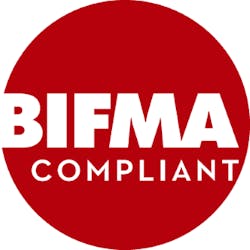Whether you are new in your career, a veteran, someone who’s never heard of the Business and Institutional Furniture Manufacturers Association (BIFMA) or are curious to know what is new, this article will demystify the furniture selection process. You will begin to understand what you need to know to ensure that your client’s furniture will perform as intended and is safe for the users, and how you can easily incorporate wellness and sustainability attributes.
(Photo: At NeoCon 2019, the BIFMA 7th floor booth was being set up. That year, the association’s message of PRODUCT | PERFORMANCE | PEOPLE was being highlighted; Courtesy of BIFMA)
The association, formed in 1973, is best known for developing voluntary safety, performance and sustainability standards that define product performance. BIFMA is an accredited standards developer through the American National Standards Institute (ANSI).
BIFMA also takes part in activities including:
- Advocating for regulatory conditions that enhance value and foster innovation
- Tracking market data and changes affecting the furniture industry
- Educating stakeholders on the importance of our standards through accredited CEU programs
- Serving as a forum to provide feedback from the market directly to its members
Because of decadeslong involvement with manufacturers and close relationships in the design community, BIFMA has knowledge and understanding about what it takes to specify furniture.
Use Current Standards
BIFMA’s process for regularly reviewing and updating standards means that designers can rest easy if a product has been tested to one of the most recent versions. The new BIFMA Compliant program has criteria related to this built right in. Soon, all you’ll need to look for is the BIFMA Compliant logo.
Use the Correct Standards
Given the voluntary nature of the standards, the question that invariably follows is, “How do I know if the furniture I’ve selected meets the right standards?” Good question, and the answer can depend on who your client is.
As a baseline, BIFMA has safety and performance standards covering a range of typical furniture that’s required in commercial settings. BIFMA suggests that any furniture that’s intended for one of these settings and for which there is a relevant standard should be in conformance to that standard. BIFMA standards represent the basic rule set for establishing furniture safety.
However, some products go beyond this baseline when it comes to wellness and sustainability. If your client or your firm’s practices are interested in these areas, then seek products that are LEVEL certified. These can be found at levelcertified.org.
Government Projects
The General Services Administration (GSA), the department that does most of the purchasing for the federal government, has historically added its own requirement related to conformance with BIFMA’s voluntary standards. If you’re working on a government project, all the furniture must be listed on the appropriate GSA schedule, which is another way of saying the official “list” for pre-approved vendors and products.
Among the criteria that a furniture manufacturer has to comply with to be considered for selection on government projects:
- Furniture products must pass the relevant BIFMA standards to be listed on the GSA schedule
- The manufacturer must affirm this in writing to the GSA
- For sales to the Canadian government, furniture must achieve LEVEL sustainability certification as of Oct. 31, 2019
With so many vendors and even more products to keep tabs on, this can be challenging for the GSA to enforce. But a manufacturer exposes themselves to great risk of being on the wrong side of this federal mandate if they can’t show conformance to BIFMA standards. As a very large purchaser of furniture, the federal government wants to ensure that people aren’t exposed to safety risks, that products will perform during their lifespan and that waste is avoided—both solid waste from the discard of non-performing furniture and fiscal waste inherent in the replacement process.
Client Projects
Increasingly, purchasers and end-users—whether they support people’s furniture needs in a hospital, a university, or even their company’s corporate real estate holdings—are concerned with making decisions that align with the broader values of the organization.
Considerations for communicating with your client to align with their values why you specify furniture that conforms to BIFMA standards include:
- Ensuring worker safety
- Reducing their environmental footprint
- Enhancing the wellness of their workforce (attraction and retention has a clear economic dimension)
- Avoiding potential risk of litigation if products in the environment cause harm
Your client may or may not have policies specifically connected to the furniture in their space. Ask if there are any policies or limitations you should be aware of.
Design Leadership Considerations
Some design firms are taking leadership on their own by incorporating internal policies and/or client guidelines related to selection of furniture. In the increasingly competitive world of design services, and in response to the rapidly changing look of commercial spaces, this is proving effective for firms to protect their clients and to minimize their own risk exposure.
HOK is one example. Tom Polucci, senior principal and firmwide director of Interiors, led the adoption of such a policy that is being implemented as a global practice. “We felt it was important to be clear on this issue,” he says. “Products that have not been tested to BIFMA standards should not be used in commercial spaces. It’s as simple as that.”
Even if your client or your firm has policies in place (and especially if they don’t), BIFMA’s latest initiative will answer the “How do I know?” question.
The BIFMA Compliant database launches in October, and will list furniture that has gone through BIFMA’s verification process to ensure products have been tested in an ISO accredited lab. This official registry of all BIFMA Compliant products will always be accessible from BIFMA.org. But designers and specifiers will also be able to easily identify this furniture when doing your typical research on manufacturer’s websites or using other product libraries. Look for the BIFMA Compliant logo, which can only be used with verified products.
“With all the crossover of furniture from the residential sector into commercial environments, especially in amenity spaces, the ability to clearly identify and distinguish products that conform to BIFMA standards from those that do not has never been more needed,” says Tom Reardon, executive director of BIFMA.
[Related: How to Specify: Sustainable Furniture Podcast]
Wellness and Sustainability Considerations
In addition to the development of guidance criteria related to ergonomics, BIFMA has been active in protecting worker wellness for a long time. Another critical aspect of wellness for inhabitants of all commercial space is indoor air quality (IAQ) and chemical exposure.
BIFMA responded early to this issue with both a standard for IAQ and development of the test method for measuring VOCs, which are the particles in the air that contribute to adverse health impacts. Most of the major certification programs that address IAQ refer to BIFMA’s test method, including GREENGUARD, WELL, LEED and LEVEL.
Beyond exposure, a broader measurement of sustainability of furniture products and the companies who manufacture them became increasingly important to BIFMA’s members along with the rise of the green building movement.
When it comes to sustainability with all its breadth and complexity, third-party certification mechanisms are the best tool for consumers to separate legitimate claims from those that may not be legitimate. When BIFMA developed its sustainability standard, it also created LEVEL, the branded certification program to go with it. At present, there are over 4,600 LEVEL certified products, far more than any other sustainability standard with multiple attributes. All are listed on the searchable LEVEL database. There is no added cost to your client or your firm to use these products, so this is a great place to start when making furniture selections that you can trust will meet environmental, social and wellness criteria.
Stay Informed
Annie Lee, principal of interior design with ENV and current IIDA New York chapter president, says it best, “It’s very important for interior designers to understand the BIFMA standards. We need this information to help our clients make the right furniture purchase decisions."
With tools like LEVEL and BIFMA Compliant, you have information in a reliable way that is fast and easy to access. You can trust BIFMA and the safety, performance and sustainability standards that it develops. Visit BIFMA.org for direct links to all the BIFMA programs discussed here.
Experience other How to Specify topics:
- Textiles
- Take the Guesswork Out of Carpet Specifications
- Commercial Carpet
- Sustainable Furniture
- Kitchen & Bath
- Plumbing
- Wallcoverings
About the Author: Jennifer Wammack is BIFMA’s director of outreach, a role created in 2017 to enhance engagement with the design community.



